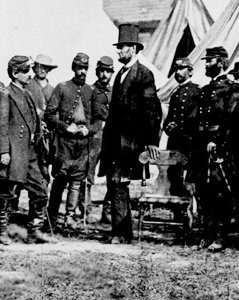
|
|
|
|
The Collodion or Wet Plate Process
Starting in 1842 and lasting to the end of the 19th century the collodion process using wet glass plates became the process of choice.
Its main advantage was the sensitivity of the emulsion. Because the plate was wet with water the silver salts would seperate into ions of
bromide, chlorine, or iodine. This would make the silver ions more receptive to collecting photons. The photons would raise the outer orbit electrons
to a higher energy state thus making the silver ions less likely to recombine back into a salt. The wet plate had to be exposed, developed and fixed while the
plate was still wet (about 10 minutes).
This was a messy undertaking that had to be performed in the dark, but exposure times were now down to 5 - 10 secounds in direct sunlight. Still not fast enough
to capture movement or even fast enough to require a shutter (the photographer could still just remove the lens cap, count off the secounds and recap the lens),
however it was a far cry from the heliograph with an eight hour exposure.
Now with a portable darkroom a photographer could take poritrature, landscape, city scenes and even the battlefields during the civil war. Anything that
would stand still for several secounds in direct sunlight was fair game.
|
 
Troops resting in field President Lincoln at Anteitam
|
|
|
Dry Plates and Roll Films
By the 1900's silver emulsions were placed on a flexible transparent base that could be purchased in flat sheets and rolls.
The film could be stored, exposed, and stored again before developing. A portable darkroom was unnecessary and several different camera formats
evolved in order to accommodate the film sizes. Up till now all negatives were contact printed (same size) so if you wanted large prints, you needed large
negatives, and a large format camera to shoot the sheets or plates.
Roll film was usually a smaller format and once loaded in the camera several frames could be shot before the roll was unloaded and processed.
Some rolls used a black paper backing so that after the film was on a take up reel you could open the camera and remove the film in sunlight.
Popular sizes included 127, 120, 220, and 612. Prints were made by the contact method, or with the use of the enlarger, biger prints could be created.
|
|
|
|
The Need for Speed
In order to take clear photograps of moving objects, shutter speeds of 1/30th of a secound and shorter were needed.
There are several ways to decrease exposure time. You can increase the diameter of the lens, called lens apeture.
You can increase the amount of light on your subject by moving into direct sunlight or using a flash. Or you can increase
the light sensitivity of your film.
Film sensitivity was increased by adding more silver salts to the emulsion making more photons give up their energy.The light energy
stored in the outer electron shell of the silver is called a "latent image". When the latent image is bathed in a developing solution,
the silver atoms combine together forming a silver "grains". These silver "grains" would clump together suspended in the film emulsion.
The unexposed silver salts would dissolve in a hypo bath and wash away from the clear emulsion. By the earlier 1900's with more sensitive films
and stronger developers shutter speed were now approaching 1/30 of a secound and less.
|
|
|
|
High Speed and Multiple Frames
In order to decide a popular debate of the day, does a horse lift all four feet off the ground at the same time, Eadweard Muybridge devised a
plan to provide photograph proof. In 1878 he placed multiple cameras in a row and let a trotting horse trip the shutters with wires placed in
the path of the horse. The resulting sequence of photographs clearly show at one point all four feet are off the ground. When shown in rapid
succession the photographs actually show the motion of the horse and rider. This is a precursor to the motion picture camera invented by Thomas Edison
a few years later in 1891 called the kinetoscopic camera.
|
|
|
|
Folding Cameras
In 1898 Kodak introduces their folding camera. This was a way to combine large format roll film with a compact portable camera.
Excellent quality pictures could be made and the camera could be carried and stored quite easily. This format was very popular and
was made up until the 1950's.
|
 
Extended - Folded
|
|
|
The Kodak Brownie
was the first mass marketed camera which sold for 1$ in 1900 and continued through the 40's and 50's.
Now the general public could take snapshots of anthing and everything. Photography had come of age.The cardboard box had a simple spring
shutter and fixed focus lens with no controls but a shutter button. Just point and shoot then wind the film to the next frame.
|
|
|
|
|
|
|
|
|
|
|
|
|
|
|
|